The purchase of a 245 hectare sheep and beef finishing farm last year means that Siver Fern Farms’ chief executive is now ‘walking the talk’, according to an article in the Otago Daily Times. As a farm owner, the article says, Cooper better understands farmers’ problems and challenges and is using that knowledge to help shape the company to meet those needs. Read more …
Tag Archives: beef
Fast Fresh n Tasty
 Silver Fern Farms’ lamb and venison are two of the ingredients being used in a handy dandy, recipe-to-shop smartphone application produced here in New Zealand, by Wellington-based digital media company ClickSuite.
Silver Fern Farms’ lamb and venison are two of the ingredients being used in a handy dandy, recipe-to-shop smartphone application produced here in New Zealand, by Wellington-based digital media company ClickSuite.
The company’s research showed a large number of people surf the web for culinary inspiration when they are in the supermarket and are hungry for new recipe ideas to add to their average five to seven recipe repertoire. The app, which was developed with plenty of hands on consumer testing (and tasting), features local producers and introduces new recipes each season incorporating relevant produce.
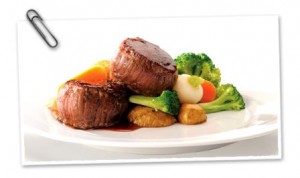
Just one example of what the users see to tempt them into trying Silver Fern Farms’ retail packs of venison medallions.
“It took real vision for Silver Fern Farms to jump on board before the app was launched,” says ClickSuite’s managing director Emily Loughnan, adding that she’s excited now that the use of the app “is truly bringing in extraordinary stats.”
Reportedly selling like hot cakes – the Fast, Fresh n Tasty app was said to be recently at the top of the Apple App Store list outselling Jamie Oliver’s and Nigella Lawson’s own – and, more importantly, being used regularly, with over 12,000 accessing it last month. Nominated for three awards in the 2012 TVNZ Marketing Awards – best new emerging business, best technology and best marketing awards – Loughnan says it’s still early days but plans are to take it global, using seasonal produce in other markets.
The NZ$5.29 app was reviewed recently at sciblogs.
Nearly quarter of a billion being invested in red meat
 Nearly a quarter of a billion dollars is being invested by the meat industry and the government in projects aimed at adding a potential $3 billion to returns over the next decade.
Nearly a quarter of a billion dollars is being invested by the meat industry and the government in projects aimed at adding a potential $3 billion to returns over the next decade.
Ministry for Primary Industries (MPI)’s director-general Wayne McNee took the opportunity at the Red Meat Sector Conference to announce approved funding for the latest Primary Growth Partnership programme, which will enable the production of high-value marbled grass-fed New Zealand beef for premium export and domestic markets.
The initiative will develop marbling in grass-fed beef in the New Zealand beef herd, using Wagyu beef genetics, McNee explained. “MPI will invest in this programme with Brownrigg Agriculture and Firstlight Foods. The PGP is committing $11 million over seven years, for a programme worth a total of $23.7 million.”
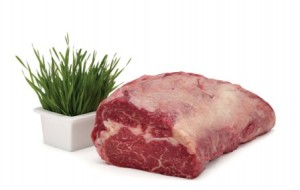 Marbling, the distribution of fat through meat, is a primary determinant of quality in table beef in international markets such as Japan, China and the United States. Internationally, such high quality beef is produced mainly from cattle housed in pens and fed grain. ANZCO Foods has been producing a supply of hand-selected steers for Japan, raised on grass but finished on Canterbury grain at the Five Star beef feedlot near Ashburton for over 20 years.
Marbling, the distribution of fat through meat, is a primary determinant of quality in table beef in international markets such as Japan, China and the United States. Internationally, such high quality beef is produced mainly from cattle housed in pens and fed grain. ANZCO Foods has been producing a supply of hand-selected steers for Japan, raised on grass but finished on Canterbury grain at the Five Star beef feedlot near Ashburton for over 20 years.
To produce a comparable meat fed using New Zealand grass, the new PGP programme is aiming to develop an integrated value chain for the beef. It will combine high marbling Wagyu sires for the yearly mating of dairy heifers and cows and the development of rearing and grazing systems that will support year-round growth of the cattle.
McNee said the programme aligns well with the Red Meat Sector Strategy.
“The programme will produce unique New Zealand high-value beef for discerning consumers. It will link specialists in dairy farming, cattle breeding, finishing, processing and marketing and deliver market signals effectively right through the value chain,” he said.
David Brownrigg of Brownrigg Agriculture says it will be a significant opportunity for beef and dairy farmers to lift the quality and value of their calves and finished cattle.
“The New Zealand dairy sector represents an under-utilised resource for producing quality beef calves. Brownrigg’s Wagyu crossed with ‘Kiwi’ dairy cows and Angus beef cows will produce outstanding beef and help us lift our game in international markets,” according to Brownrigg.
 Gerard Hickey, managing director of Firstlight Foods says a planned marketing programme to selected high-end global consumers will enable beef farmers to build their businesses with confidence.
Gerard Hickey, managing director of Firstlight Foods says a planned marketing programme to selected high-end global consumers will enable beef farmers to build their businesses with confidence.
Minister welcomes announcement
Welcoming the announcement, Minister for Primary Industries David Carter says, “The Government’s total investment so far of more than quarter of a billion dollars in PGP programmes, demonstrates its firm commitment to boosting economic growth through primary sector research and innovation.
“All New Zealanders stand to gain from the partnership because, alongside our internationally prized lamb, our beef sector is pivotal to the success of our economy.”
The announcement lifts the total government-industry PGP spend over the past three years to nearly $600 million. Nearly $86 million of government PGP funding has been allocated to three meat industry projects worth a total of nearly a quarter of a billion dollars to date. These are estimated to potentially put over $3 billion more on the country’s GDP by the mid-2020s.
To date, PGP-supported meat projects include funding of up to $59.5 million over seven years for the $151 million Farm IQ project with partners Silver Fern Farms, PGG Wrightson and Landcorp Farming aimed at creating a demand-driven integrated value chain for red meat. Seven project streams and 18 sub-projects are working to improve the capture and utilisation of both market and farm production information. The information will then support the development of new value-driven genetics and extension work that underpin the programme.
Another $36.6 million PGP project with NZ Merino, including $15.15 million of PGP funding, is looking to develop merino sheep with meat, wool and other products suitable for market demands over the next seven years.
Also in the wings, is a project that has been approved to business plan stage and will potentially to be funded to the tune of $37 million, led and matched by funds from Beef + Lamb NZ Ltd focused on implementing a number on-farm elements of the Red Meat Sector Strategy. Other meat industry projects are also in the pipeline, according to MPI.
The PGP is expected to be fully subscribed by next year, says McNee.
An abridged version of this article appeared in Food NZ magazine (August/September 2012).
Be smart: keeping consumers happy
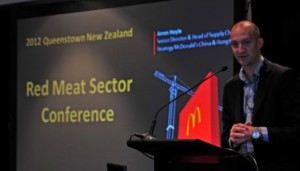 Keeping its consumers happy and listening to what they want has significantly improved McDonald’s business performance including financial returns, according to one of the company’s top China-based executives.
Keeping its consumers happy and listening to what they want has significantly improved McDonald’s business performance including financial returns, according to one of the company’s top China-based executives.
Introduced as a “good friend of New Zealand beef” at the Red Meat Sector Conference, Arron Hoyle, McDonald’s senior director and head of strategy for China and Hong Kong and a major customer for New Zealand’s lean manufacturing beef, said that the result deserved “a massive thank you to the New Zealand meat industry.”
McDonald’s had selected New Zealand and Australia as its sources of beef for the region because of the two countries’ reputations for food safety. While the US is still the largest market for the company, the company is significantly growing its presence in the APMEA countries.
In 1990, McDonald’s entered China, the fastest growing market in the world, when it opened its first store in Beijing. In 2010, it had 1,000 stores open and by 2013 will have 2,000.
All new stores will have a uniquely McDonald’s style, reflecting Chinese expectations for a modern, trendy image.
“We found that we need to ensure consistency in supply of style and expectations.”
There is no silver bullet, he went on to say. “You have to work extremely hard and to understand your consumer better than your husband or wife.”
He believes that New Zealand is well positioned to grow in Asia, particularly in China with its need to “import virtual water” due to ever growing water constraints as the country develops.
The Chinese market changes rapidly depending on the supply/demand dynamic. McDonald’s is forecasting beef growth to 7-8 million tonnes a year by 2020 and McDonald’s China demand alone to surpass 60,000 metric tonnes per annum.
McDonald’s likes to think it’s a great partner for NZ, says Hoyle, “the industry and all suppliers we partner with, we really like New Zealand beef. We don’t manage the supplier, we manage the business together in a partnership with suppliers.”
For the New Zealand beef team, it’s going to be a case of being better at the value chain, to execute against the opportunity, measure effectiveness versus efficiency and being faster than the competition to solutions.
“The data is showing us the opportunity is behind the hill. We need to work together to get there,” he said.
This article appeared in Food NZ magazine (August/September 2012).
Delivered: second Red Meat Sector Conference
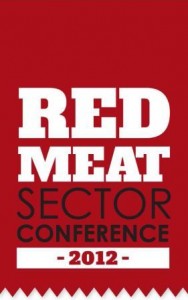 Delivered, as promised: Excellent, inspirational and thought-provoking speakers, all appearing in a packed programme for the 250 delegates attending the second Red Meat Sector conference.
Delivered, as promised: Excellent, inspirational and thought-provoking speakers, all appearing in a packed programme for the 250 delegates attending the second Red Meat Sector conference.
Congratulations must go to the Meat Industry Association (MIA) and Beef + Lamb NZ Ltd (B+LNZ), joint organisers of this year’s well-attended Red Meat Sector Conference at Rydges Lakeland Resort hotel in Queenstown.
Alongside heartening optimism for future demand for red meat, recurrent themes were the massive potential for New Zealand of emerging markets in Asia, especially China, water issues, the need to utilise best practice, the need for all links in the chain to tell the industry’s story to the public, plus the rapid emergence of social media as a tool for communicating with consumers.
 In his opening comments, MIA chairman Bill Falconer also noted that, while not as quickly as some would like, encouraging progress is being made on the Red Meat Sector Strategy and that “small starts are being made across the board.” Later in the day Rob Davison, from the B+LNZ Economic Service, outlined a number of matrices that the Economic Service is developing that will help to track progress against the strategy, and these matrices will “focus conversations, thinking and actions to drive the future”.
In his opening comments, MIA chairman Bill Falconer also noted that, while not as quickly as some would like, encouraging progress is being made on the Red Meat Sector Strategy and that “small starts are being made across the board.” Later in the day Rob Davison, from the B+LNZ Economic Service, outlined a number of matrices that the Economic Service is developing that will help to track progress against the strategy, and these matrices will “focus conversations, thinking and actions to drive the future”.
The Conference also saw the announcement of new Primary Growth Partnership (PGP) funding for the red meat sector, for a project to develop high-value grass-fed marbled beef, using Waygu genetics.
All the presentations were a veritable smorgasbord of information, packed with facts, statistics and views from many facets of the industry, enabling delegates to pick out what was relevant for their part of the value chain. While every single one of the speakers was passionate and eloquent about their topic, from an export food manufacturing perspective the highlights were excellent presentations from McDonald’s Arron Hoyle and vertically integrated meat processor Agri Beef’s Rick Stott from the US.
Besides the serious business, there was entertainment and laughter too. Lunch – finger food featuring B+LNZ Ambassador chef Ben Battersbury’s speciality “alternative cuts, not cheap cuts” like lamb riblets – was amusingly heralded with witty comments from him. After dinner speaker Davey Hughes of Swazi Apparel gave an hilarious account of hunting expeditions in Africa and shared a few (tongue-in-cheek) items from his latest collection, including a new ‘mankini’.
Also noteworthy, was a significant Australian presence at the conference in the form of representatives from Meat & Livestock Australia and Aus-Meat. This put physical form to MLA’s managing director Scott Hansen’s opening comment in his presentation that “Australia sees a close collaboration with New Zealand.”
There was positive feedback from delegates, who came from all parts of the sector, including farmers, processors, equipment suppliers, researchers and media.
This article appeared in Food NZ magazine (August/September 2012). Copies of most of the conference presentations are available at www.mia.co.nz or redmeatsector.co.nz.
Stock numbers holding
 The good pastoral production year has seen New Zealand sheep numbers increase by 2.6 percent and beef cattle numbers increase by one percent for the year to 30 June 2012, according to Beef + Lamb NZ Ltd’s Economic Service.
The good pastoral production year has seen New Zealand sheep numbers increase by 2.6 percent and beef cattle numbers increase by one percent for the year to 30 June 2012, according to Beef + Lamb NZ Ltd’s Economic Service.
“This partly makes up for the 4.4 percent decline in sheep and 2.6 percent decline in beef cattle the year before,” says executive director Rob Davison.
B+LNZ’s annual stock number survey, which establishes the productive base of livestock for 2012-2013 shows that while sheep numbers were up 2.6 percent most of this increased will be stock carried over for slaughter in July-September.
Ewe condition is good across the country, he noted. “Scanning results for most regions show in-lamb ewes are carrying more multiple lambs with the general comment that scanning percentages are up five to 10 percent on last year. All we need now is an excellent sprint to ensure high survival of the lambs born.”
The scanning results lead to expectations that the 2012 lamb crop could be up on last Spring by one million lambs (+ four percent). This outcome would lift the ewe flock performance measured by lambing percentage to around the highest achieved, which in 2009-2010 was 123 percent. There is potential to exceed this performance level, Davison says. Each one percentage point change in lambing percentage, equates to about 200,000 lambs.
Full cup, steady hand
 While New Zealand sheepmeat producers have been enjoying a ‘full cup’ in recent times, with strong farmgate returns, a ‘steady hand’ will be needed to balance future production levels with demand uncertainty across European markets.
While New Zealand sheepmeat producers have been enjoying a ‘full cup’ in recent times, with strong farmgate returns, a ‘steady hand’ will be needed to balance future production levels with demand uncertainty across European markets.
A newly released report Sheepmeat – full cup, steady hand from global agribusiness banking specialist, Rabobank, says that the strong farmgate returns in the past two seasons, have been as a result of retail price increases and limited supply availability.
Report co-author Hayley Moynihan says global sheepmeat supplies are forecast to increase from 2013, off a low productive base, although this volume growth is expected to be modest and availability will not recover 2010 levels until 2015.
“While sheepmeat demand has softened in developed markets, we expect retail prices will normalise at new levels – typically 10 percent higher than the three-year average for most regions,” she says.
“For New Zealand producers, a positive outlook will persist in export markets as the economic outlook improves and the market balance remains tipped in their favour.”
As the governments of the EU countries seek to restore balance to their economies, policy changes are expected to place increasing pressure on consumer purchasing powers, says Moynihan. In real terms, the increased cost of living for the average EU consumer is likely to exceed any growth in income, at least for the next 12 to 24 months.
Meat price inflation has led the charge in annual food prices, averaging 4.5 percent year-on-year, with eastern European countries experiencing increases as high as 10 percent in 2011.
“These factors can be expected to weigh heavily on sheepmeat demand and to limit growth prospects.”
Rabobank is picking a slow recovery for developed markets through to the end of 2013. “Emerging markets will continue to grow, albeit slightly below the rate of previous years and offer opportunities for sheepmeat demand growth,” says Moynihan.
The Rabobank report says retail prices will also be influenced by continued strength of competing meat prices; the impact of lower beef production from the US and EU on global supplies; and the rising beef production costs from Brazil, China and Australia..
“These factors are likely to mean that retail price movements for lower-value cuts will continue to rise faster than high-end cuts. This will be particularly evident across emerging economies and consequently only provide limited upward pressure on farmgate returns for exporters,” it says.
Moynihan says that by 2015, sheepmeat production from key exporting regions is expected to lift by an additional 135,000 tonnes a year, which would bring global export supply back to 2010 levels.
Transformational change (and how to make it)
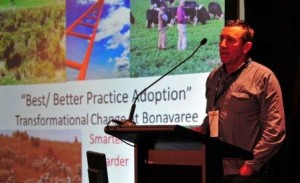 One farmer who has made transformational change to his farm business is Marlborough farmer Doug Avery.
One farmer who has made transformational change to his farm business is Marlborough farmer Doug Avery.
In an inspirational and entertaining presentation at the Red Meat Sector Conference, he talked of working “smarter and harder” and the need to “lift yourself up above and see what’s going on around you.”
The tipping point that made him see that he needed to change was sustained drought in the region, over a period of eight years, which meant that Bonavaree Farm and the Avery family were facing a very uncertain future. In 1998, Doug Avery attended a seminar where Lincoln University pasture Professor Derrick Moot proposed using lucerne as a primary grazing pasture plant. Using that idea started change.
In 2004, with the area still gripped with drought, the NZ Land Care Trust answered a call for help from Avery and a few other farmers. A six-pronged attack on failed systems was engaged with science and the help of funding from the Sustainable Farming Fund and others. This saw the transformational change of the operation from one of failure to one of success.
Having run the emotional gamut of the ‘Three Ugly Sisters’ – envy, anger and blame – Avery realised, when he started looking, that there were some things he could control and others he was concerned about – climate change, weather and the value of the dollar – that he had no control over at all.
Avery realised three things: that the farm business could run 44 percent less sheep but only produce five percent less product; also, that a one percent increase in soil carbon can increase water holding capacity by 144,000 litres per hectare; and, finally, “how much time do we spend telling our story?”
Change of mindset
A change of mindset was also needed, he decided. He would work in what he calls the influence circle, become proactive not reactive, move to solution and enquiry (away from blame and excuse), he would influence thinking and adapt his business systems to the changing climate.
Better practice influenced the systems in place at Bonavaree, says Avery. The year was broken down into three periods: the risk period from mid-December to mid-February where they farm as little as possible; the recovery period from mid-February to late winter, when crops are grown on summer-fallowed land and ewes and hoggets are mated on lucerne and the system charges back into life; and the revenue period, from late summer till mid-December.
“We grow our stock at fast rates to finishing weights before the summer dry,” he said, adding that ewes wean fat and the ewe weights are heavy.
Precious water was conserved by using summer fallow, which intercepted the weed cycle, storing water and creating a water reservoir. Organic matter was built into the soil by stopping tillage. Plants were used that could tap water from deeper layers and also create rapid animal growth and performance. Finally, animals were made for performance, using designer genetics.
Results
The results today speak for themselves. “Lots of wonderful lambs that grow like mushrooms”, and “hogget scanning gone from 40 percent to 165 percent”.
Today, Bonavaree has 1,500 hectares owned and 280 ha leased which will be wintering 13,000 stock units this year (5,000 sheep, 1,650 cattle), growing 90 ha of lucerne for seed and the family is retiring an increasing number of natural areas production. The property has six full-time staff and lots of busy contractors.
Better practice
Better practice for Avery is about using quality contractors, rather than trying to purchase expensive machinery and do it himself, using smart systems like Farmax, inspiring the young who learn by what they see, working with good value chains and smart brands, growing top crops and lambing onto top quality feed, he said.
Reminiscing to the start of his transformational journey, Avery said: “I always wondered why somebody didn’t do something about that, then I realised I am somebody.”
His message for farmers looking to create resilient businesses is to create relationships, manage the soil and water “more crop from every drop”, look at the plant selection for sites and purpose, manage feed supply and demand, work with the natural forces of the local climate, collaborate with science, agency and industry, engage in processes which create financial reward and to create a culture of excitement and fun in the work place.
Bonavaree is now looking to build on its successes through improved management structures, more measuring and collaboration through FarmIQ, better feed conversion in the rumen, improved plant mixes and genetics (plant and animal) and enhanced native plantings and over lay business, says Avery.
Doug Avery has received a number of award for his work at Bonavaree including the 2008 Green Ribbon from the Ministry for the Environment, 2010 Lincoln Foundation South Island Farmer of the Year, 2011 Marlborough District Council Farm Environment Award and the 2012 New Zealand Land Care Trust Ambassador title.
Firstlight Foods hits Hollywood
Link
Firstlight Foods’ grass-fed Wagyu Beef has just been launched at Bristol Farms’ “extraordinary food stores” in Beverly Hills and Hollywood (US that is). Read more …
Production boom confirmed by MPI
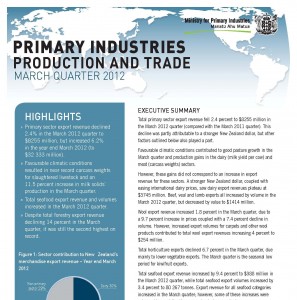 The production boom, alluded to by several at the Red Meat Sector Conference, has been confirmed in the Ministry for Primary Industries (MPI)’s latest primary industry statistics released today. They show increased production of beef and sheepmeat, corresponding with growth in the export volumes for the meats, but falls in export revenue earned from lamb and venison.
The production boom, alluded to by several at the Red Meat Sector Conference, has been confirmed in the Ministry for Primary Industries (MPI)’s latest primary industry statistics released today. They show increased production of beef and sheepmeat, corresponding with growth in the export volumes for the meats, but falls in export revenue earned from lamb and venison.
‘Primary Industries Production and Trade‘ for the March quarter 2012 is the first release of a new combined primary industry quarterly report, comprising production and trade statistics for the meat, dairy, wool, forestry and seafood industries. It replaces separate quarterly reports for forestry and seafood that were previously released by the Ministry.
The report shows that the primary sector continued to be an economic driver, with total primary sector exports accounting for 71 percent of all merchandise exports in the year to March 2012.
MPI reports favourable climatic conditions led to a continuation of better-than-usual pasture growth during the March 2012 quarter. As a result, farmers achieved near-record carcase weights for slaughtered livestock and an 11.5 percent increase in milk solids’ production, compared with the same quarter in 2011.
However, the stronger New Zealand dollar coupled with easing international dairy prices meant that overall primary sector export revenue for the quarter was down 2.4 percent on the previous year, at $8.3 billion.
At the same time, total export revenue for the year to March 2012 was up 6.2 percent on the previous year at $32.3 billion.
In the year to the end of March 2012, exports of New Zealand’s beef and veal, lamb and mutton, venison and other meats, earned revenue of $5.6 billion, while hides, leather and dressed skins added a further $591 million to the export pot. This made a total of $6.233 billion, accounting for 13.6 percent of total NZ merchandise exports.
According to the report, beef production increased by 1.4 percent in the March 2012 quarter (compared with the March 2011 quarter), due to increased carcase weights, the highest since 2006. This was despite lower adult cattle slaughter numbers. Lamb production was up 2.4 percent because of increased slaughter numbers and a record average carcase weight of 17.6 kg.
The volume of beef and veal exported increased 1.3 percent to 98,450 tonnes in the March quarter, in the March quarter, while export value decreased 4.5 percent to $570 million because of the strong New Zealand dollar. Beef and veal exports to New Zealand’s major export market, the US, increased 9.3 percent by volume and 5.3 percent by value because of stronger demand.
Export volumes of lamb increased 4.7 percent to 79,000 tonnes, while export values decreased 1.3 percent to $722 million. Lamb exports to New Zealand’s main market, the European Union, decreased 9.1 percent by volume and 9.6 percent by value, which the report says was due to a decrease in frozen export volumes and increased export sales to China and OPEC.
Revenue earned from venison exports fell slightly by 0.4 percent at the end of March 2012, compared to the previous year, though volume had dropped by 4.3 percent.
A pdf copy of the report can be downloaded by clicking the link below or at the MPI website (search on ‘Primary Industries Production and Trade’).

